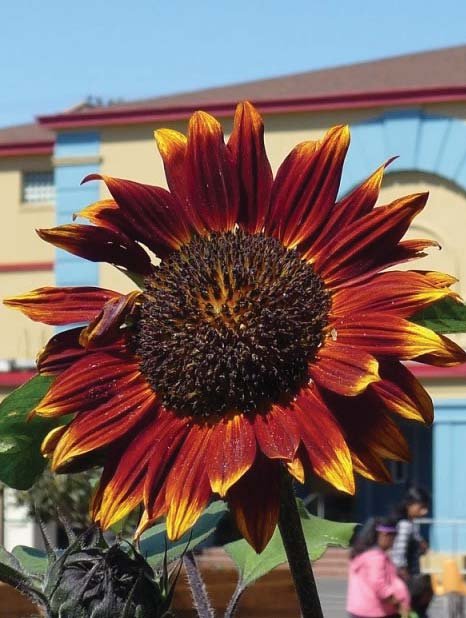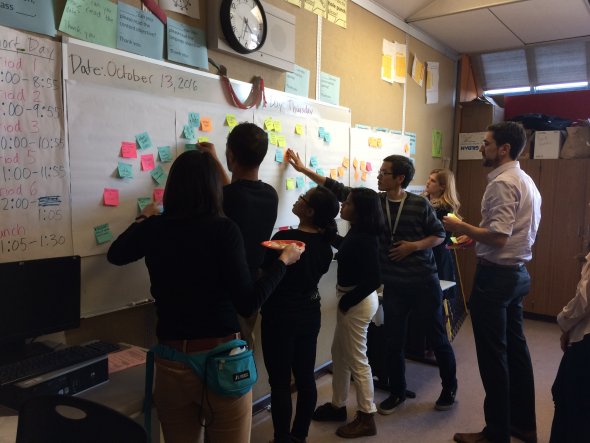Innovation Awards Overview Link to this section
What is the Innovation Award Grant?
From 2014-23, schools had the opportunity to apply to redesign an aspect of their work that tackled an equity dilemma and further developed the skills and competencies of the Graduate Profile for all students.
This program has provided funding for schools to bring new practices and solutions to educational challenges for over a decade. The iLab has been a vehicle facilitating this change in building human capacity and providing a toolkit of resources. The focus of the award has continued to evolve to match the changing needs and focus for SFUSD over time.
For the 2023-24 school year, our district has adopted goals, values and guardrails that address our most pressing needs and are designed to accelerate achievement for all students. Consistent with this, the Innovation Awards will be focused on Guardrail 2a: Reducing Chronic Absenteeism and used to support schools that meet particular criteria; these schools will be notified directly about their eligibility and steps to participate.
Please note that while the Innovation Awards has a much more narrow scope this year, the iLab resources are still available for sites to utilize at their discretion, and the Impact Awards will continue and be offered to all schools to apply. The application for the Impact Awards will be available in August with notices in Oasis as well as on the Impact Award web page.
2022-23 Innovation Award Participants:
- Longfellow Elementary School is designing instructional strategies focused on bilingualism and identity, using WLES mentorship, so teachers can more consistently meet the needs of their students across their Spanish Bilingual Pathway Program so that students would be able to celebrate their bilingualism by meeting self-selected academic goals.
- John O’Connell High School is designing opportunities for their school community to build strong relationships and a more inclusive school culture where students can participate and collaborate in meaningful ways so that students develop character as well as self-efficacy, agency, and motivation.
- Mission High School is designing conversation and collaboration strategies that provide their newcomer students with more opportunities to develop academic and conversational English in their classes so that they will engage more frequently and fluently in authentic English conversations to develop and deepen their content understanding and build relationships with peers and community.
- Rosa Parks Elementary School is designing inquiry based instructional strategies that provide more equitable access for all students in their STEAM program so that students can more easily persist in the face of difficulties and develop multiple strategies to solve hard problems.
2021-22 Innovation Award Participants:
Daniel Webster Elementary School, George Peabody Elementary School, Lakeshore Elementary School, Alamo Elementary School, Leonard R. Flynn Elementary School, John Muir Elementary School, John O’Connell High School, San Francisco International High School, Sheridan Elementary School
For the 2021-22 school year, the QTEA Innovation Award winners engaged in a design process to create, test, and implement demonstrations of learning that allow students to celebrate their humanity and reflect on their path toward proficiency in the knowledge and skills of the Graduate Profile in partnership with their teachers. In monthly professional learning communities (PLCs), school design teams learned together with other schools engaged in similar work.
2020-21 QTEA Innovation Award Participants:
- Dianne Feinstein Elementary School is rethinking their teacher practices and student supports in Designated ELD to address the persistent opportunity gaps for English Learners in order to increase student engagement and scores on standardized tests.
- Jefferson Elementary School is researching and designing outdoor learning spaces that could enhance both the educational experience of Jefferson students as well as students across other sites in a safe and sustainable way.
- Longfellow Elementary School is exploring ways to deepen their family relationships, create more culturally responsive pedagogy, and expand their teacher practices in order to support their Spanish Biliteracy pathway students to thrive academically, socially and emotionally.
- San Francisco International High School, Mission High School, and Thurgood Academic High School in partnership with SFUSD’s Multilingual Pathways Department are focused on how to create effective curriculum and support for newcomer students in mathematics in order to increase engagement, participation, and lessen the stark opportunity gap that currently exists especially in distance learning..
- Shoestring’s Children's Center is partnering with families and caregivers to provide home learning school supplies, resources, and supports in order to create optimal and customized at-home learning experiences for their students.
- Starr King Elementary School is designing 4th-5th grade portfolios and defenses of learning to support opportunities for students to demonstrate learning through performance assessments, as well as considering how K-3 can engage in and support the portfolio process.
- Webster Elementary School’s 3rd-5th grade educators are engaged in student artifact collection, revision, and reflection, in advance of student presentations during spring conferences.
- Willie Brown Middle School, Starr King Elementary School, and Visitacion Valley Middle School in partnership with SFUSD’s AAALI department are investigating how participatory action research can enhance youth voice as a way to promote the creation, elimination or revision of the policies that most negatively affect marginalized youth in the district.
- Zaida T. Rodriquez Early Education Center is seeking to better understand the barriers to engagement facing Latinx and African American students in order to increase English language and literacy acquisition skill development.

George Washington Carver Elementary
Increasing Instructional Time for African American Male Students

Glen Park Elementary
Designing an Inviting and Supportive Wellness Center

Buena Vista Horace Mann
Increasing Academic Achievement for English Learners

San Francisco International High School
Creating a Continuation School for Immigrant Youth

Vistacion Valley Middle School
Creating Environments to Cultivate Empowered Readers
This page was last updated on July 24, 2023

